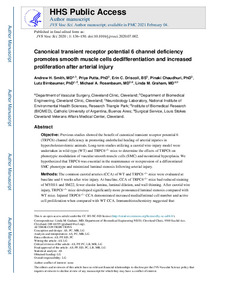Por favor, use este identificador para citar o enlazar este ítem:
https://repositorio.uca.edu.ar/handle/123456789/11623| Título: | Canonical transient receptor potential 6 channel deficiency promotes smooth muscle cells dedifferentiation and increased proliferation after arterial injury | Autor: | Smith, Andrew H. Putta, Priya Driscoll, Erin C. Chaudhuri, Pinaki Birnbaumer, Lutz Rosenbaum, Michael A. Graham, Linda M. |
Palabras clave: | TRPC6; LESIONES; TECNICAS QUIRURGICAS; SISTEMA CARDIOVASCULAR; GENES; PROTEINAS; CELULAS; FISIOPATOLOGÍA | Fecha de publicación: | 2020 | Editorial: | Elsevier | Cita: | Smith, A. H., et al. Canonical transient receptor potential 6 channel deficiency promotes smooth muscle cells dedifferentiation and increased proliferation after arterial injury [en línea]. Postprint del artículo publicado en: JVS- Vascular Science. 2020, 1. doi: 10.1016/j.jvssci.2020.07.002. Disponible en: https://repositorio.uca.edu.ar/handle/123456789/11623 | Resumen: | Abstract: Objective: Previous studies showed the benefit of canonical transient receptor potential 6 (TRPC6) channel deficiency in promoting endothelial healing of arterial injuries in hypercholesterolemic animals. Long-term studies utilizing a carotid wire-injury model were undertaken in wild-type (WT) and TRPC6−/− mice to determine the effects of TRPC6 on phenotypic modulation of vascular smooth muscle cells (SMC) and neointimal hyperplasia. We hypothesized that TRPC6 was essential in the maintenance or reexpression of a differentiated SMC phenotype and minimized luminal stenosis following arterial injury. Methods: The common carotid arteries (CCA) of WT and TRPC6−/− mice were evaluated at baseline and 4 weeks after wire injury. At baseline, CCA of TRPC6−/− mice had reduced staining of MYH11 and SM22, fewer elastin lamina, luminal dilation, and wall thinning. After carotid wire injury, TRPC6−/− mice developed significantly more pronounced luminal stenosis compared with WT mice. Injured TRPC6−/− CCA demonstrated increased medial/intimal cell number and active cell proliferation when compared with WT CCA. Immunohistochemistry suggested that expression of contractile biomarkers in medial SMC were essentially at baseline levels in WT CCA at 28 days after wire injury. By contrast, at 28 days after injury medial SMC from TRPC6−/− CCA showed a significant decrease in the expression of contractile biomarkers relative to baseline levels. To assess the role of TRPC6 in systemic arterial SMC phenotype modulation, SMC were harvested from thoracic aortae of WT and TRPC6−/− mice and were characterized. TRPC6−/− SMC showed enhanced proliferation and migration in response to serum stimulation. Expression of contractile phenotype biomarkers, MYH11 and SM22, was attenuated in TRPC6−/− SMC. siRNA-mediated TRPC6 deficiency inhibited contractile biomarker expression in a mouse SMC line. Conclusions: These results suggest that TRPC6 contributes to the restoration or maintenance of arterial SMC contractile phenotype following injury. Understanding the role of TRPC6 in phenotypic modulation may lead to mechanism-based therapies for attenuation of IH. | URI: | https://repositorio.uca.edu.ar/handle/123456789/11623 | ISSN: | 2666-3503 | Disciplina: | MEDICINA | DOI: | 10.1016/j.jvssci.2020.07.002 | Derechos: | Acceso abierto | Fuente: | Postprint del artículo publicado en: JVS- Vascular Science. 2020, 1 |
| Aparece en las colecciones: | Artículos |
Ficheros en este ítem:
| Fichero | Descripción | Tamaño | Formato | |
|---|---|---|---|---|
| canonical-transient-receptor-potential (1).pdf | 1,86 MB | Adobe PDF |  Visualizar/Abrir |
Visualizaciones de página(s)
86
comprobado en 27-abr-2024
Descarga(s)
97
comprobado en 27-abr-2024
Google ScholarTM
Ver en Google Scholar
Altmetric
Altmetric
Este ítem está sujeto a una Licencia Creative Commons

